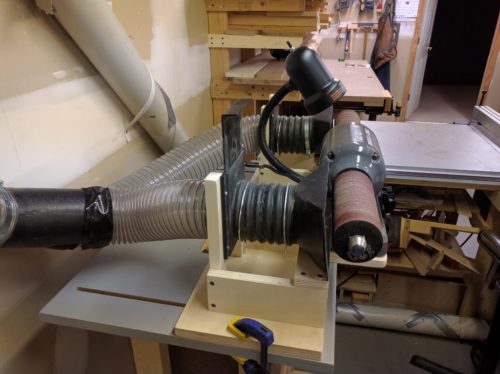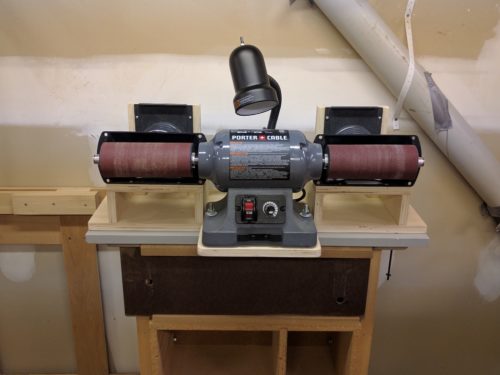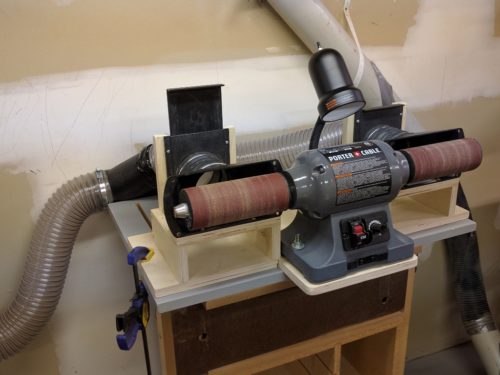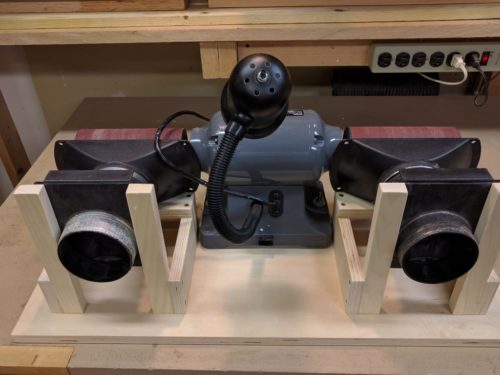I recently decided to try my at intarsia and I quickly realized that it involves lots of sanding. Much of this sanding involves rounding the edges of pieces in order to create a 3D effect and perhaps the best way to perform this task is with either a flex or pneumatic sanding drum. The softness of these drums allows them to partially wrap around edges to produce a curved surface rather than the flat surface created by a conventional hard sanding drum. In addition to intarsia projects, there have been other times when I needed to round edges so I reckoned a dedicated soft drum sanding station would be a good addition to the shop.
I made my sanding station from a Porter Cable variable speed grinder that cost $120. For safety reasons, it’s best to sand at relatively low speeds, say 1700 to 2000 RPM. The motor on this grinder turns at 2000 RPM at its slowest setting. I removed the guards and grinding wheels and replaced the wheels with flexible sanding drums, 80 grit on one side and 120 grit on the other. The drums were part of a Flex Drum Kit by Treeline that I picked up on Amazon for $38. I also bought two extra padded sleeves for $6 each. The kit includes 8″ long aluminum mandrels that slide over the motor shaft and are held in place with set screws. The foam padded sanding sleeve then slides over the mandrel which has four lengthwise protrusions to better hold the sleeve in place.
Most of the construction effort for the sanding station went into dust collection. I mounted a small dust hood (POWERTEC 70150 – $6) directly behind each sanding drum, followed by a small section of 4″ dust collection hose that connects to a blast gate. Each dust port connects to a Y connector (POWERTEC 70106 – $9) and from there, the unit connects to the dust collection system. Given how much fine dust this type of sander can produce, I felt it was important to provide individual control of each sanding drum for maximum dust suckage (although I did discover that dust removal worked quite well even with both ports open).

Side view of sanding station. The top of the drum rotates toward the operator so sanding is best performed using the front or bottom of the drum.
The dust collection components are held in place by simple plywood frames. The blast gates screw into two uprights and the 9″ wide dust hoods screw into a plywood cross piece. The frames are secured to a base piece of plywood which is clamped to the router table. The overall footprint of the sanding station is 30″ wide by 14″ deep. To facilitate sanding of long pieces, I bolted the motor to a bump-out in the middle of the base (see above), leaving plenty of vertical space below the drums. The only drawback to this design is that if I do a quick sanding job without turning on the dust collector, the dust falls onto the floor. Perhaps I’ll mount some sort of retractable panel to deal with this “incidental” dust.
So far, I’ve been quite pleased with the flex drum sanding station. I use the 80-grit drum for rough shaping and then follow up with the 120-grit drum. I have other sanders such as a mop sander for final sanding. Going forward, I may attach a catch screen to the dust ports to prevent small pieces that escape my grip from being sucked into the dust collector, although this hasn’t been an issue…yet.




